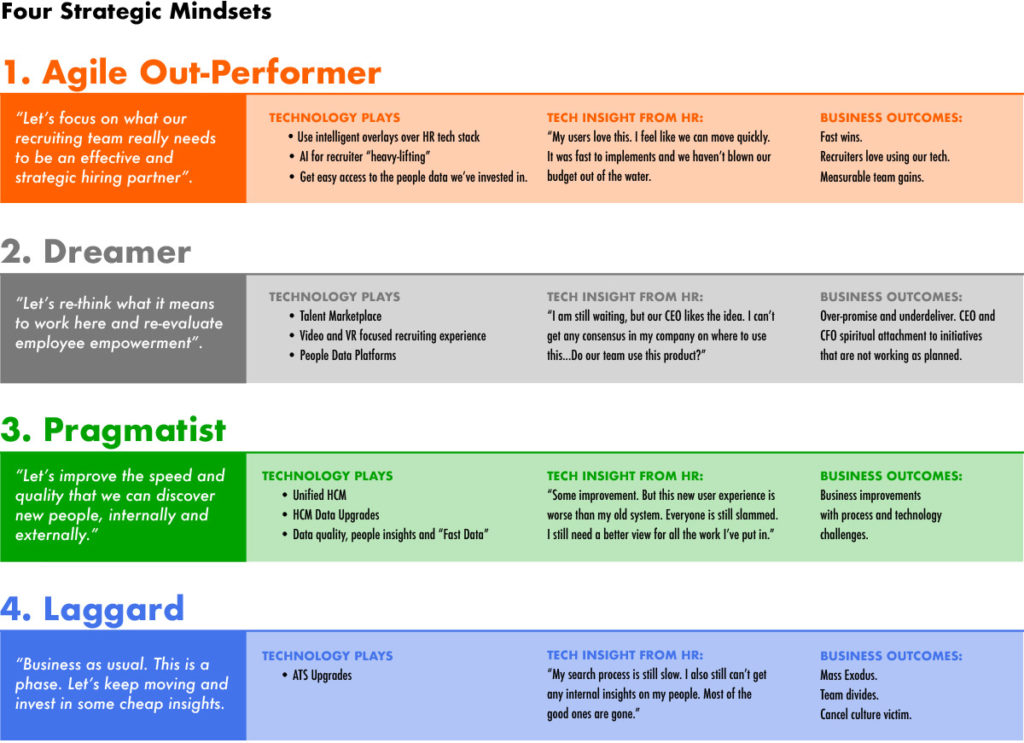By Polo Crosbie and Spencer Liu, Product and Strategy at MojoHire
Your talent acquisition team’s attitude towards HR tech is a tell-tale sign of how change-ready it is. Which one of these four organizational agility mindsets best describes your team?
Whether you call it the Great Reassessment, the Great Resignation or the Big Quit, one thing is certain: it has never been more difficult to attract top talent than it is today. (Preferences around what to call this talent revolution differ depending on how optimistic you are, how you are feeling about the current state of HR, day of the week, and how many coffees you may have had ☺).
Per the latest official government data, more than 4.5 million people voluntarily left their jobs in November. That’s up from 4.2 million in October and was the most in the two decades that the government has been keeping track of it. The surge in quitting in recent months — along with the continued difficulty reported by employers in filling openings — underscores this strange, contradictory moment facing the U.S. economy after two years of COVID-related disruptions (source).
Unfortunately, talent acquisition leaders’ problems don’t end there. The Great Resignation’s impact has been further compounded by the sad fact that most HR technology stacks are old and broken. In fact, the average mid-sized organization runs more than nine separate HR technologies to support day-to-day operations – often connected by a patchwork of custom integrations stitched together with short-term business process workarounds. All of these factors have made it increasingly difficult for leaders to move decisively and quickly enough.
Four strategic mindsets to investing in HR technology
As this tidal wave of change continues to roll in on top of talent acquisition (TA) teams, we’ve seen four strategic organizational agility mindsets that characterize how companies are tackling these problems and investing in their HR technology stacks to improve their organizational agility (organizational agility is the ability to rapidly adapt to market shifts):
- The Optimistic Dreamer
- The Data-Driven Pragmatist
- The Reluctant Laggard
- The Agile Outperformer

The Optimistic Dreamer
Optimistic Dreamers are the teams that see the Great Resignation as an opportunity to rethink what it means to work and be part of an organization, and to improve upon the organizational agility of the company. They have invested heavily in complex AI-driven employee marketplaces, doubled down on new capabilities from their human capital management (HCM) systems, and developed new referral programs that invite existing star employees to recommend their friends. The C-suite has spent time assessing employee marketplaces and has big plans to integrate its frontend recruiting experience into the new employee experience.
These types of initiatives have had three major impacts:
- The C-suite has a vested interest in seeing these employee marketplace tools work quickly since they, not TA, made the decision to invest in them.
- Sweeping HR change management initiatives are now needed to train and equip the employees and hiring managers that use the marketplace tools.
- Given the huge amount of money companies have already sunk into these tools, they find themselves committed to spending even more.
Don’t get us wrong. We love ambition, and we are big fans of employee marketplace platforms, but they are slow burners. They take years to start producing ROI. The average cost of a new employee marketplace is well over $2M. That’s before you think about integrating this environment with your HRIS. So now, the innovator in TA is in a bind – they want to innovate, but a huge amount of their HR portfolio budget that could be used for sourcing new people is tied up in technology that is going to take another 24 months and millions of dollars to produce any results.
Meanwhile, in the real world, the tidal wave of change continues unabated.
The Data-driven Pragmatist
The Pragmatists are the data junkies and schedule-minded project managers. These TA teams want to be cost-conscious and get the most out of existing systems while continuing to deliver projects on time.
Pragmatic teams have doubled down on new sourcing technologies (in their minds, more data = more chances of success), amped up advertising, and even looked at integrating their entire applicant tracking system (ATS) environments with their HCM. All this to attempt to increase organizational agility.
This has led to an explosion in the amount of HCM and “data optimization” projects that are currently in flight across most mid-sized to large HR organizations. Similarly, it has spawned a host of new consulting companies that are wholly dedicated to running effective HCM projects and big data initiatives.
The Data-driven Pragmatist mindset has driven the following interesting outcomes:
- Vast pools of siloed candidate information now sit unused in various environments.
- The user experience from the TA and recruitment teams’ perspective is still sub-par. (Let’s be honest – the user experience with most of the leading ATS platforms lies somewhere between frustrating and painful.)
- Teams are still working in spreadsheets, on LinkedIn, or don’t use the multitude of tools they are supposed to log in to (but don’t because of point 2 above).
The Pragmatists are now in a bind, too. After spending millions on data optimization projects and sourcing tools, their recruiting teams are still sitting on LinkedIn pouring hours of time into manual search efforts, because they either don’t have access to great people, or their search platform’s UX makes it too cumbersome to discover them. If they were already having trouble keeping up before the tidal wave hit, now they are practically drowning!
The Reluctant Laggard
If you thought things were bad for the others, spare a thought for the Laggard. These are the people and teams that still refuse to believe that anything has changed at all. While the tidal wave mercilessly rolls on, these folks have gone back to bed and lend any thought to organizational agility. (Admittedly, there are fewer Laggards now than 6 months ago).
These organizations have taken a big hit. People continue to leave, nobody impactful is arriving, and the remaining bastions of corporate culture are stretched so thin that they have lost the lust to carry on. Mind you, they may still be convinced that a small investment in an ATS upgrade is going to revolutionize their chances of bringing great people into the organization, but by then, the Laggard won’t have a recruiting team to use it.
The Agile Outperformer
As the storm rages on, our customers naturally ask: “What happens now with how I invest in my HR stack?” “What can I actually do to make things better?” And, “How can I deliver outcomes with meaningful results for both our people and our bottom line?”
Fortunately, there is a mindset that takes organizations to higher ground so they can not only navigate the tidal wave but thrive amidst it. It’s the only mindset that drives sustainable organizational agility. Agile Outperformers unify their siloed data repositories and prioritize speed, access, and an ergonomic user experience (UX) to equip their TA teams to discover the best talent quickly, whether it be within the employee ranks or outside the company – all while protecting and leveraging investments already made. Agile Outperformers recognize they need quick wins and want to get the most of the investments they have already made in their tech stack. Leadership in this mindset includes traits like:
- Envisioning the recruiting team as a competitive asset and strategic hiring partner to hiring managers
- Prioritizing the recruiter experience in the company as a strategic business goal
- Leveraging investments already made in existing data sets for faster wins
Promote Organizational Agility and Become an Agile Outperformer with MojoHire
This is the mindset MojoHire was created to enable. MojoHire’s AI-enabled solution unleashes the power of your existing HR tech stack to provide immediate access to talent that would otherwise have gone overlooked and undiscovered. Have you seen similar mindsets in your organization or within your teams? We love a good story. Reach out to us and share your insights!
polo@mojohire.ai
spencer@mojohire.ai
[elementor-template id=”1304″






